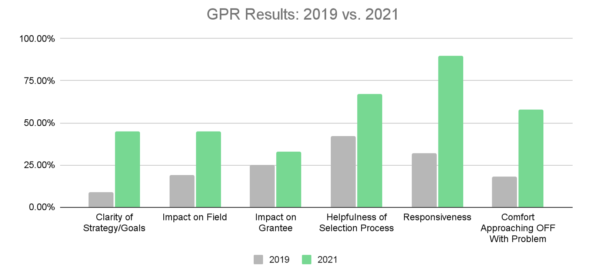In part one of this blog post, we shared the humbling results of the Overdeck Family Foundation’s 2019 Grantee Perception Report, as well as how the Foundation came together to process that data and formulate a plan to move forward. We suggest you read part one before diving into this post, where we share the action that followed that 2019 assessment as well as our most recent GPR results — a measure of the success of our actions.
Taking Action
With a deep understanding of our results and a shared desire to learn better, together, we identified three priorities and the resources it would take to address these key areas, including time, people, and funding. Highlighted below are some of the specific actions we took to address these top priorities.
Priority 1: Clarify the Foundation’s Goals and Strategy
To improve the clarity of our goals and strategies, we took a multi-pronged approach. First, with our trustees, we clarified our funding model and strategy to align on what we were trying to achieve, how we were going to achieve it, and how we would assess impact.
Following the revision of our funding model, we focused on communicating our goals and strategies, internally and externally. We continued to dedicate staff time and resources to sharing grantee news monthly on our blog, but revamped our editorial strategy and calendar to better highlight the purpose of the new funding model: grantee innovation, evidence-building, and growth.
Finally, and importantly, we regularly dedicated team time to ensure everyone understood the funding model and strategy and felt comfortable communicating about it with grantees and the field.
Priority 2: Providing More Non-Monetary Assistance
In light of our low scores on the impact we have on grantee partners, we prioritized non-monetary support in our updated funding model and revamped program staff time to encourage deeper and more frequent connection with grantees.
To respond to grantee requests for more support outside of funding dollars, the Foundation incorporated more non-monetary assistance into our funding model and daily workflow. For example, we set aside nearly $1 million in dedicated support for helping organizations increase their ability to collect and analyze data; conduct cost analysis and financial modeling; and collect beneficiary feedback to drive internal strategic planning and improvements. We also redefined the program officer role — from transactional to transformational relationships — committing alongside our program staff to encourage check-ins with grantees to be a collaborative process involving shared problem solving and brainstorming, not just an update on goal progress. We believed the latter would also be a crucial component to helping us strengthen the quality of our relationships with grantees.
Priority 3: Improving our Grantmaking Process
To improve our grantmaking processes, we assembled a cross-functional team dedicated to reviewing best practices from other funders to see what works and what we could borrow and use (thank you to Arbor Brothers and Echoing Green)! Using that research, we redesigned all grantmaking documents, from due diligence and selection to reporting and monitoring, to align with our revamped funding model.
Along the way we continuously sought feedback, engaging grantees in the process of testing and commenting on the new templates and creating grantee-facing documents explaining our process. In addition to being clearer and more streamlined, we hypothesized that our updated process would improve the quality of our grantee relationships by improving transparency about expectations and timelines.
Continuing to Improve and Learn
To hold ourselves accountable, we integrated specific goals and targets in our organization-wide and individual Objectives and Key Results aligned with these three priorities. We committed to checking in on our progress semi-annually and to conducting the GPR with our grantees once again in 2021 to measure progress on our commitments.

We were excited to see improvement across the board in nearly every category, as you can see in the chart above. In addition to improvements on these questions, we saw large gains in the strength of our relationships with grantees, who reported feeling that we were respectful and honest, and felt more comfortable approaching us with challenges than in 2019. Given that the strength of our relationships with grantees is critical for the success of our collective work, these improvements validated the changes we made.
The initial feedback from our 2019 survey was difficult to see, but it was a critical moment in our growth and learning as an organization. Understanding what our partners needed from us in concrete and specific ways allowed us to prioritize and put in place an improvement plan. And seeing measurable improvement has energized our efforts going forward.
Here’s 10 key takeaways we formed about what matters most after receiving critical feedback that we would lift up for other foundations:
- Commit to building a learning culture, rooted in results and data analysis; this will ensure that “difficult” data gets the same attention as positive data.
- Get curious and develop hypotheses about challenges in team-wide settings that invite open discussion and debate; this ensures accountability and buy-in by everyone.
- Make it a norm to name weaknesses and failures by modeling this as a leadership team.
- Identify dependencies, required resources, and where collaboration is required; improvement is a team sport.
- Articulate organizational priorities on key challenges; this improves buy-in and ensures that everyone is on the same page.
- Get leadership buy-in on the challenges and how to allocate resources to address them.
- Assign key owners and build in accountability and cycles of reflection.
- Identify key measures of success and hold the team accountable to improvements.
- Make public and specific commitments about what you hope to improve and change; what’s measured is managed and what’s communicated publicly is where the focus often goes.
- Communicate progress and challenges at specified time points; that way internal and external stakeholders know what to expect.
While our journey continues (we still have plenty room for improvement — read about our new priorities here), we hope that sharing our progress and experiences can encourage other funders to gather feedback and give them some ideas on how to actualize it to improve their operations and impact.
Anu Malipatil is vice president, Education, and Jon Sotsky is director, Strategic Learning & Impact, at Overdeck Family Foundation. Learn more and follow the Foundation on LinkedIn.


